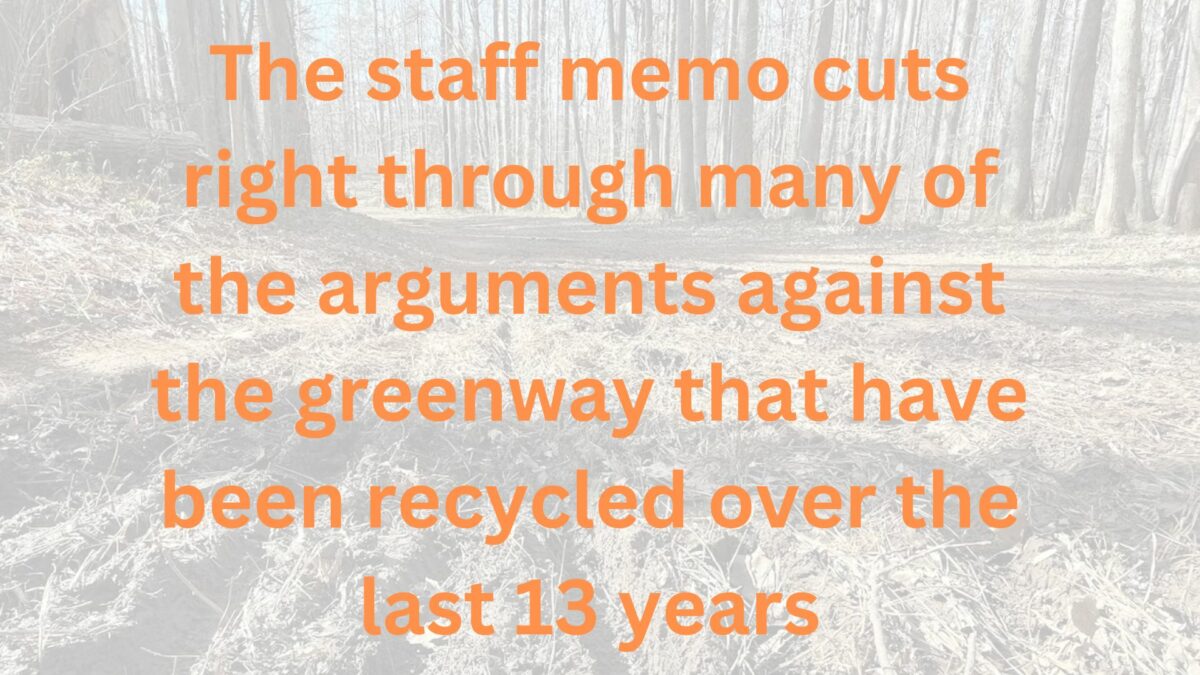On December 8th, 2009, the Carrboro Board of Alderman (now known as the Carrboro Town Council) voted to adopt the Bolin Creek Greenway Concept Master Plan as a “platform for future planning and implementation of the Bolin Creek and Jones Creek greenway trails.” The resolution before the board that evening also included a very thorough memo prepared by town staff summarizing efforts to bring the plan before the board for approval. What is so interesting about the thirteen year-old staff memo is that it addresses many of the arguments against the greenway that we continue to hear today. Go ahead and download the staff memo and follow along at home as we address some very old concerns using an official town document.
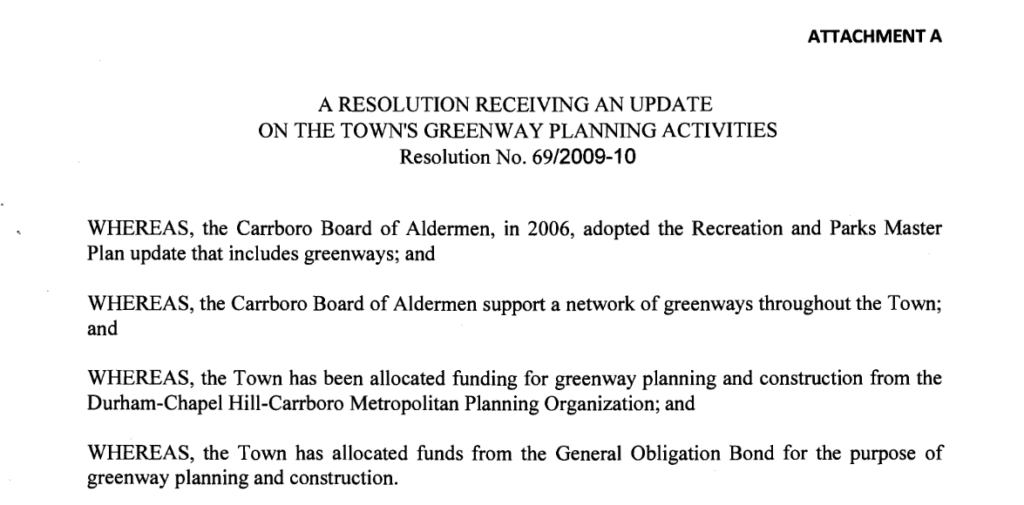
The backstory
The dream of a north-south paved greenway along Bolin Creek in Carrboro has been around since at least 1994 when it was first acknowledged in the town’s Recreation and Parks Master Plan. Leading up to the 2009 greenway concept plan effort, the town had been incorporating the Bolin Creek Greenway into its planning efforts for well over a decade.
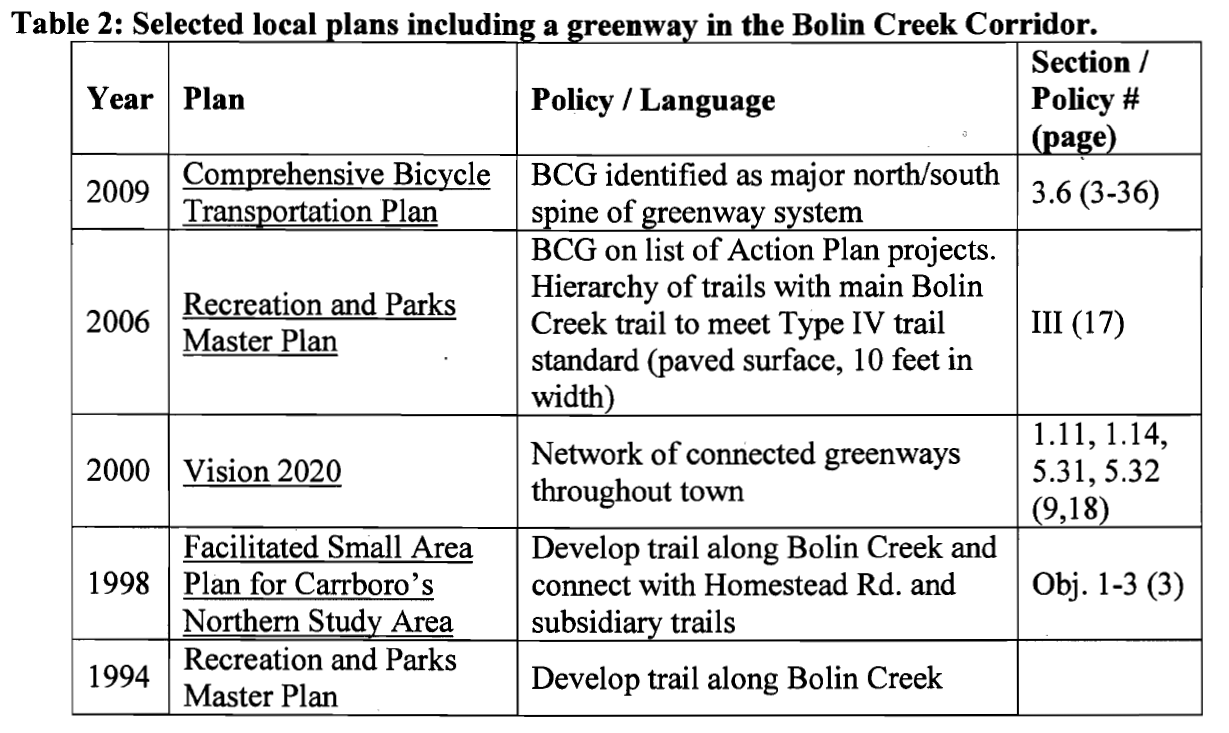
In 2008 the Town of Carrboro decided to take a major step forward in bringing about a greenway along Bolin Creek when it entered into a contract with Greenways Incorporated to produce a formal concept plan.
Greenways Incorporated was founded by Chuck Flink, currently a Professor of the Practice in Landscape Architecture and Environmental Planning at NC State University and a Fellow of the American Society of Landscape Architects. Mr. Flink has designed and built over 200 greenways worldwide, including the Grand Canyon Greenway Trail, the American Tobacco Trail, and the Arkansas Razorback Regional Greenway. In other words, Chuck Flink is an expert and his plan addresses a number of issues related to state permitting, environmental concerns, and public engagement.

Sign up for the Carrboro Linear Parks Project mailing list to get updates on building out Carrboro’s greenway network. Visit the Carrboro Linear Parks Project website for more information. There’s also a helpful FAQ with answers to many questions.
Update: We support the creekside alignment for the reasons detailed here.
Stakeholder and public input
Greenway opponents will sometimes say that there is widespread opposition to a greenway along Bolin Creek. Based on surveys and other town outreach, greenways are currently very popular amenities for Carrboro residents. Back in 2009, the Bolin Creek Greenway was a widely popular idea and the staff memo documents that fact.
In order to gauge public opinion and interest for the Bolin Creek Greenway, Greenways Inc. worked with town staff to hold public workshops which were well attended. The staff memo notes that opposition to the greenway plan from some members of the community was immediate, but that overall there was “considerable community support” for the greenway generally and specifically for the proposed alignment along Bolin Creek.
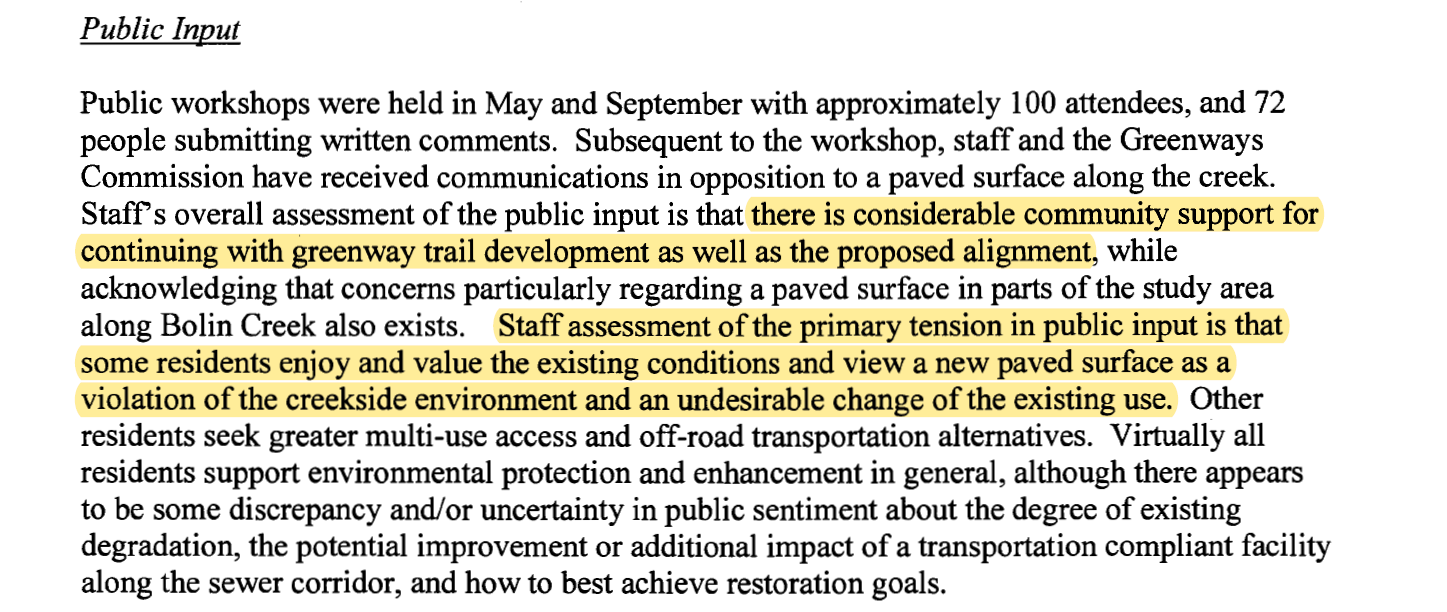
The alignment was discussed at length in the concept plan, where residents were presented with alternate routes away from the creek, including a mostly on-road route that would share space with automobile traffic. These alternative routes were rejected by the public, in part, because locating a greenway on city streets with cars is awful. Staff also note that the “primary tension in public input” was that some residents, those that live next to the creek, enjoy it as it is and do not want to see that change.
The consultants also met with stakeholders, notably OWASA and UNC, to determine their requirements and to propose designs that would satisfy all concerned parties. In a meeting with UNC and OWASA, staff from UNC expressed their desire to see the greenway installed along the OWASA easement near the creek so that additional trees would not be felled for the project.

Environmental impact of the existing easement
Opponents of the Bolin Creek Greenway often refer to the creek corridor as some pristine Eden and then cite that one Joni Mitchell song to say that pavement cannot coexist in paradise. The problem with this imagery is not merely that it is corny, but that the area around the creek is far from pristine and there is, in fact, already a road through the forest in the form of the sixty year-old sewer easement. Conditions on the easement were and continue to be bleak and well documented. The staff memo from 2009 paints this picture as well.
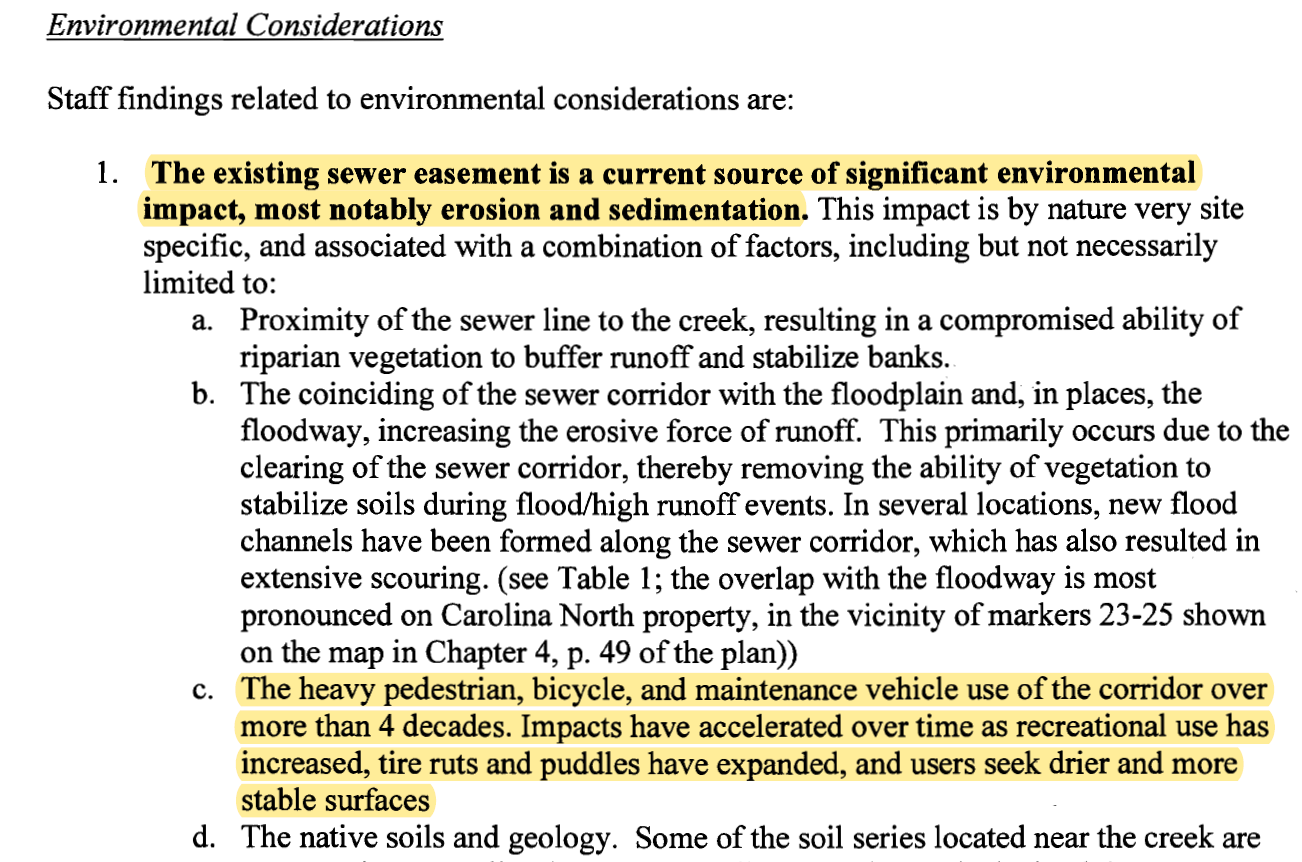
Critically, the staff memo notes that the easement is essentially impervious. Greenway opponents often cite research about the negative impacts of locating pavement next to streams, but also carefully elide the fact that we have a 30-foot wide impervious path next to the creek right now.
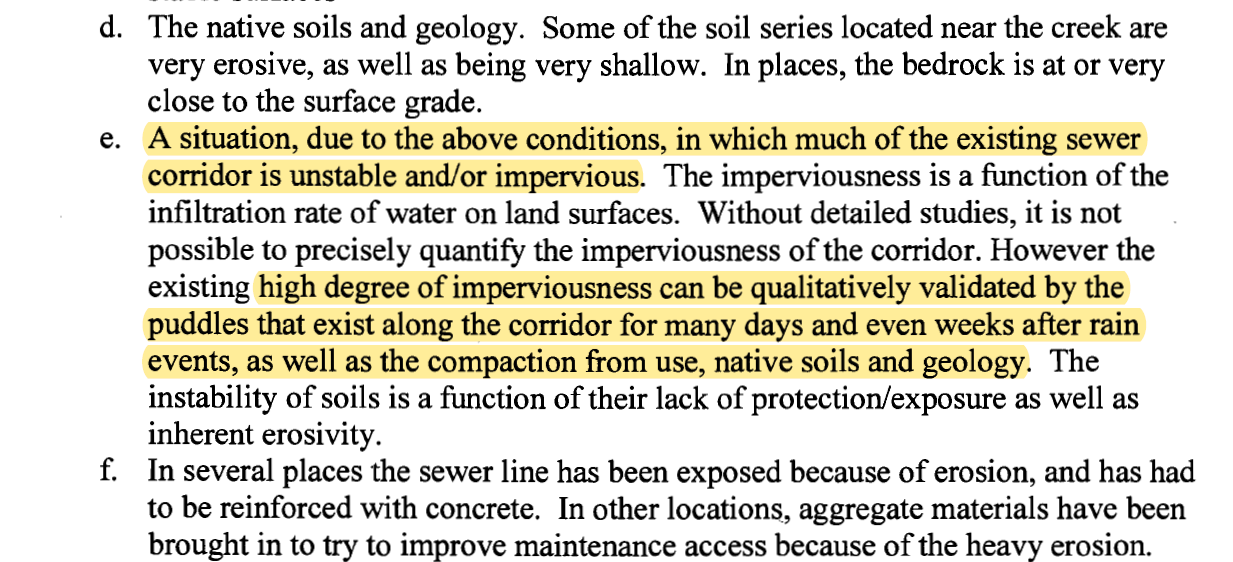
A major argument for co-locating the greenway with the sewer easement is that doing so would actually shrink the total amount of impervious surface along the creek because in dedicating ten feet to pavement for trail users we can reclaim the other twenty to forty feet with seeded shoulders and other vegetation.
The Jordan Lake rules
Greenway opponents will sometimes reference the “Jordan Lake rules” as a roadblock to building the Bolin Creek Greenway. Essentially, these rules say that you should not build things in stream buffers because it will degrade the Jordan Lake watershed. Fair enough, but there are exceptions to the rule having to do with utilities and trails when “no practical alternative” exists. These rules were in place back in 2009 and town staff and the consultant sought guidance from state regulators about a creek-side alignment in light of these rules. It seems obvious, but let’s state it: If state regulations would not have allowed a paved path next to Bolin Creek, the consultant would not have put it there in the concept plan.
In fact, the staff memo describes how the NC Department of Water Quality (DWQ) and Town of Carrboro staff met and walked the creek to discuss the water quality impacts of co-locating a paved greenway within the existing sewer easement. Not only did DWQ staff indicate that the paved greenway would be permitted under the rules, they actually encouraged the town to move forward with the greenway because it would improve conditions in the creek.
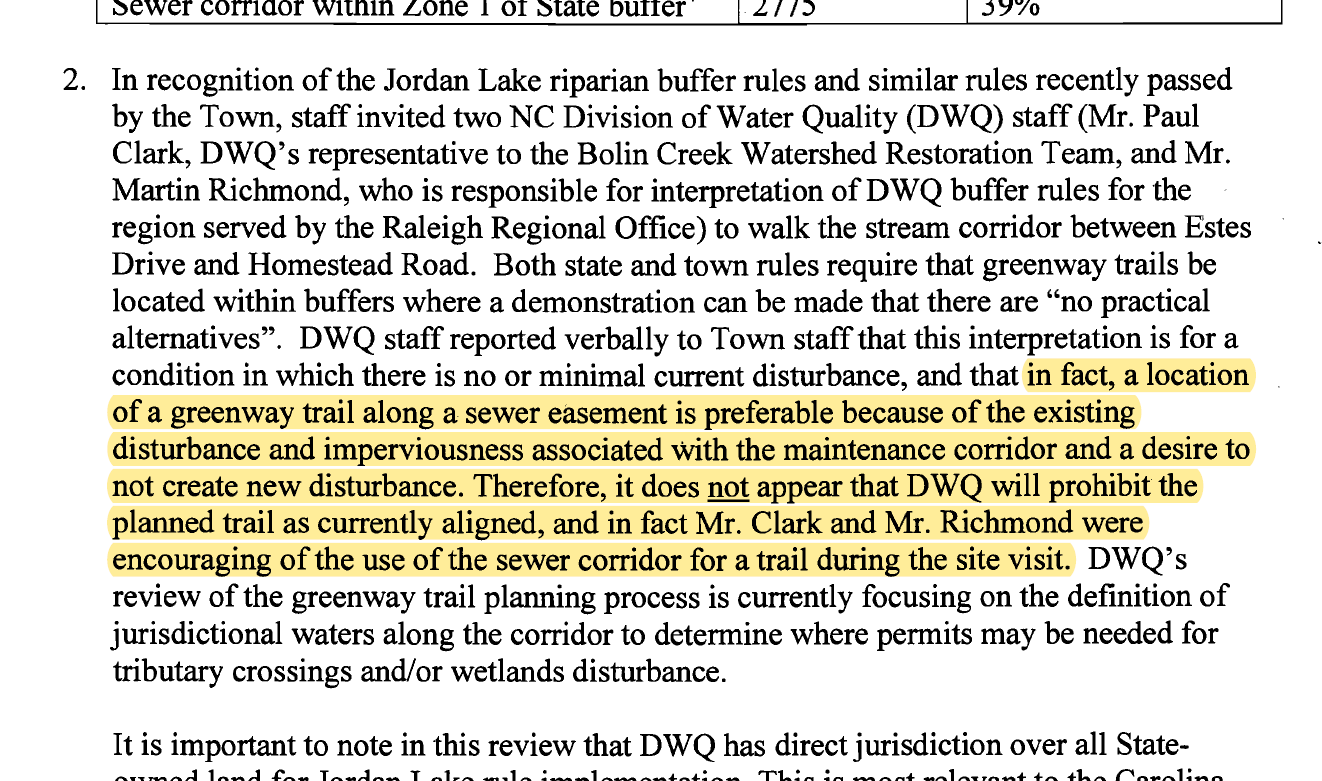
If the Carrboro Town Council votes in 2023 to direct staff to move forward with the Bolin Creek Greenway, staff will have to re-engage with state water quality regulators and obtain the necessary permits. But, if the 2009 meeting with regulators is any indication, there should be no problem obtaining those permits because the greenway will improve the water quality issues identified by staff.
Greenways are climate projects
Greenway opponents will sometimes say something along the lines of “given the climate crisis, why would we pave through one of the few remaining intact urban forests?” Well, the honest answer to this question is because it is the most environmentally responsible action we can take at this point. If town staff, and state DWQ regulators, and a world-class greenway engineer can be believed, the existing conditions along the creek were terrible in 2009 and have only gotten worse with the last thirteen years. The greenway offers a number of opportunities to mitigate this damage.
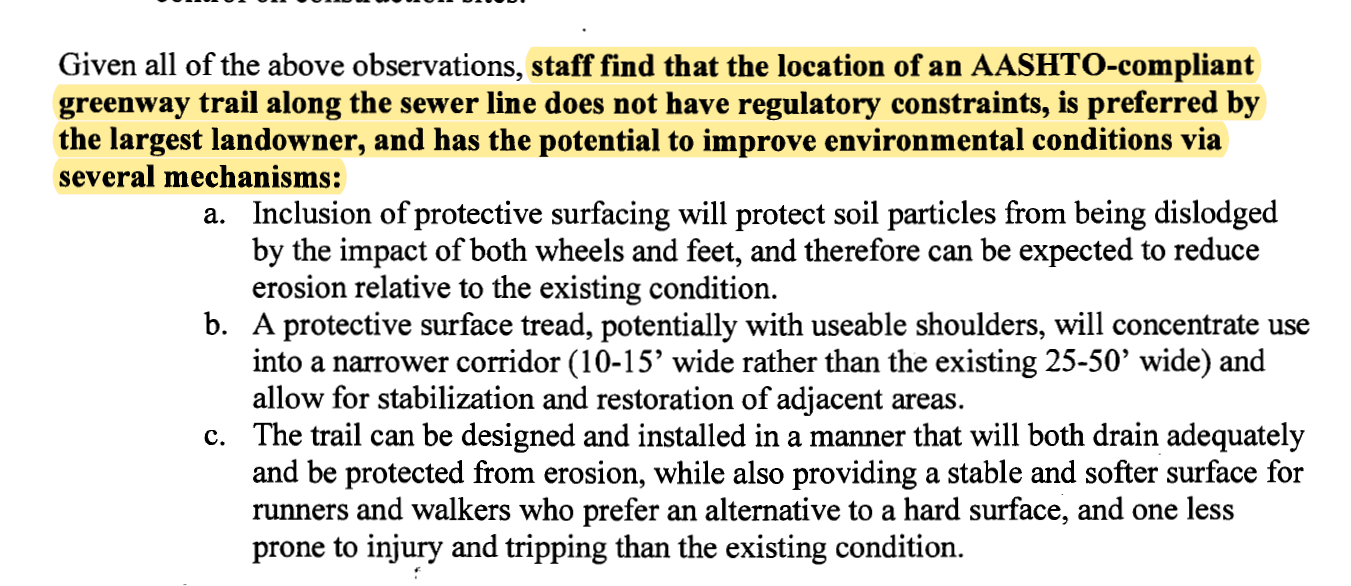
Staff note three aspects of the greenway project that would benefit the forest and the creek: (1) a paved path will reduce surrounding erosion by giving trail users a durable surface for feet and bike tires and dog paws, (2) a 10-foot paved path is less impervious surface than a 30-foot wide impervious barren easement, and (3) the greenway project will involve engineered and graded storm water treatments, which is a huge improvement over the unmanaged runoff we have now.
The staff memo also relates that the Bolin Creek Greenway would align with the town’s climate goals by reducing vehicle miles traveled. The Town of Carrboro has recently adopted a comprehensive plan that prioritizes town initiatives that demonstrate a climate impact, and getting kids to school on a greenway instead of individual car trips is a big win for the climate.

As opposed to the so-called “neighborhoodway” up Cobblestone Drive, the creek alignment is ideal because it does not have steep changes in grade, which makes it more likely to replace car trips. Staff also note that the creek-side alignment does a good job connecting schools to neighborhoods and therefore meets objectives outlined in the town’s 2012 Safe Routes to School Action Plan.

The staff memo cuts right through many of the arguments against the greenway that have been recycled over the last thirteen years. My hope is that the town council and staff can build on the work done in 2008 and 2009 with the Bolin Creek Greenway Concept Master Plan and start implementing those recommendations as soon possible.
What’s next?
The Carrboro Town Council will meet for a work session on February 14th, Valentine’s Day (awwww! ?). The work session will be centered on the question of how to conduct public engagement around this project in an equitable and hopefully expeditious manner. After the public engagement process is complete, it is assumed that the town council will then vote to move forward with the project or not. A decision to move forward simply means directing staff to start a very long process that includes identifying funding, working with landholders on obtaining right-of-way, applying for permits, and addressing areas that need further study or engineering. The 2009 concept plan spells out this process in great detail and there will be many future decision points if the council agrees to initiate the process, but we must get to the point where that initial decision can be made.
I don’t know about you, but all I want for Valentine’s Day is a productive town council work session that gives some clear direction to staff about how to move forward with public engagement and ultimately a decision from the town council.

